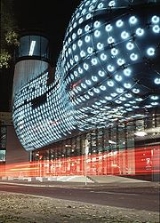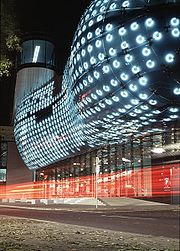
Kunsthaus Graz
Encyclopedia

European Capital of Culture
The European Capital of Culture is a city designated by theEuropean Union for a period of one calendar year during which it organises a series of cultural events with a strong European dimension....
celebrations in 2003 and has since become an architectural landmark in Graz
Graz
The more recent population figures do not give the whole picture as only people with principal residence status are counted and people with secondary residence status are not. Most of the people with secondary residence status in Graz are students...
, Austria
Austria
Austria , officially the Republic of Austria , is a landlocked country of roughly 8.4 million people in Central Europe. It is bordered by the Czech Republic and Germany to the north, Slovakia and Hungary to the east, Slovenia and Italy to the south, and Switzerland and Liechtenstein to the...
. Its exhibition program specializes in contemporary art
Contemporary art
Contemporary art can be defined variously as art produced at this present point in time or art produced since World War II. The definition of the word contemporary would support the first view, but museums of contemporary art commonly define their collections as consisting of art produced...
of the last four decades.
Architecture
Its unusual form differs radically from conventional exhibition contexts, many of which maintain the traditions of the modernist "White Cube". The team of architects used an innovative stylistic idiom, known as blob architecture within the historical ambiance of the Murvorstadt. Thus, the gigantic building affectionately called the "Friendly Alien" by its creators Peter CookPeter Cook (architect)
Professor Sir Peter Cook, founder of Archigram , former Director the Institute of Contemporary Arts, London and the Bartlett School of Architecture at University College London, has been a pivotal figure within the global architectural world for over half a century. His ongoing contribution to...
and Colin Fournier
Colin Fournier
Colin Fournier is co-architect with Peter Cook of the Kunsthaus Graz in Austria. He is also professor of The Bartlett School of Architecture, a part of University College London.-References:...
, in form and material, stands out consciously against the surrounding baroque roof landscape with its red clay roofing tiles but nevertheless integrates the façade of the 1847 iron house.
Concept
Architecture, design, new media, internet art, film, and photography are united under one roof. Kunsthaus Graz was developed as an institution to stage international exhibitions of multidisciplinary, modern and contemporary art from the 1960s to the present day. It doesn't collect, maintains no permanent exhibitions, has no permanent depot at its disposal and no research establishments. Its exclusive purpose is to present and procure contemporary art productions. Kunsthaus Graz implements an innovative concept, which offers various possibilities in its galleries to fulfill the high curatorial requirements of contemporary exhibitions.BIX Façade
The BIX Façade of the museum represents a singular fusion from architecture and New MediaNew media
New media is a broad term in media studies that emerged in the latter part of the 20th century. For example, new media holds out a possibility of on-demand access to content any time, anywhere, on any digital device, as well as interactive user feedback, creative participation and community...
and is based on a concept of the Berliner architects realities:united. BIX, a name which consists of the words "Big" and "pixels" is the acrylic glass skin of the eastern side of the building toward the Mur
Mur
Mur may refer to:* Mur River , a river in Central Europe* Mur, Switzerland, a commune in Vaud and Avenches* Mur, a large village south of Novi Pazar, Serbia* Mur, part of the village of Murzasichle, Poland...
and city center and represents an oversize urban screen, which serves as an instrument for artistic productions. BIX projects accompany different exhibitions and are not transported into the public area, also the direct environment is defined and shaped. Beyond that the "communicating outer skin" offers also a possible drilling platform for art projects, which bring up for discussion the dialogue between media and area. 930 40 Watt fluorescent rings are embedded in the 900 m² outer skin, with the illumination level of each one being steplessly variable between 0 and 100%. Each light ring functions as pixel, which can be served by a central computer. In this way they can be developed as roughly screened indications, texts and film sequences, which radiate far into the urban area and thus, the blue blister of Graz with a screen of immense size makes an art gallery.

